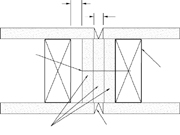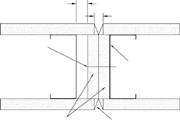
Gypsum board is a versatile, efficient and economical building material whose application can be easy and fast. However, occasional installation questions may arise that need answers in order to maintain the quality of the job. Therefore, I thought it appropriate for my inaugural column to focus on some gypsum board installation facts that you may not know. (On behalf of the gypsum board industry, I am looking forward to bringing you helpful information in this monthly column.)
Fastener is the generic term used to refer to the nails, screws and staples with which gypsum board is generally attached to framing. (Adhesives are also used with nails and screws but are generally not considered to be fasteners.) While nails are commonly used in wood frame construction, many contractors prefer screws because they can be applied with a screw gun that speeds the installation process. In addition, screws have excellent holding power. Many contractors are uncertain about using nails and screws together in the same board. A combination of nails and screws may be used, in both fire-rated and non-rated systems; nails should be used along the edges, and screws should be used in the field. Some contractors prefer staples because they are economical and can be quickly applied with a staple gun. However, staples should only be used on the base-layer in multi-layer systems or on gypsum sheathing or gypsum lath attached to wood framing.

Control joints
Control joints may be pre-fabricated or fabricated on the job site from suitable materials. Pre-fabricated control joints are manufactured in various shapes and sizes and are used to serve a number of different stress-related functions. Control joint installation methods depend on the shape and function of the joint. Locations of control joints should be shown on the plans; they must be specified by the architect or designer where any of the following conditions exist:o A partition, wall or ceiling traverses a construction joint (expansion, seismic or building control element) in the base building structure.
o A wall or partition runs in an uninterrupted straight plane exceeding 30 linear feet.
o A control joint is incorporated as a design accent or architectural feature.
Control joints for interior ceilings with perimeter relief should be installed so that linear dimensions between control joints do not exceed 50 feet and total area between control joints does not exceed 2,500 square feet.
Control joints for exterior ceilings and soffits, and interior ceilings without perimeter relief should be installed so that linear dimensions between control joints do not exceed 30 feet and total area between control joints does not exceed 900 square feet.
A control joint or intermediate blocking should be installed where ceiling framing members change direction.
Seek appropriate resources
Control joints in acoustical or fire-rated systems require special treatment to maintain the ratings. Contractors should refer to appropriate technical publications for specific installation recommendations such as those detailed in the accompanying illustration which appears in the Gypsum Association's "Fire Resistance Design Manual" (GA-600-2000).There are a few facts relating to fire-rated construction of which all contractors should be aware. For example, you may use a greater stud size (depth) in metal- or wood-stud systems than the tested size. Metal studs of heavier gauge than those tested also may be used. Remember, a stud of greater size and heavier gauge is permissible, but a stud of smaller size is not.
In floor-ceiling or roof-ceiling systems, the fire-resistance rating may be reduced by the addition or deletion of mineral or glass fiber insulation in ceiling joist spaces. You can add up to 163/4 inches of 0.5 pcf glass fiber insulation (R-40), either batt or loose-fill, to any 1- or 2-hour fire-rated floor-ceiling or roof-ceiling system that has a cavity deep enough to accept the insulation. However, if insulation is added to a system that was not tested with insulation, one additional layer of type X gypsum board, at least 1/2 inch thick, must be applied to the ceiling. This additional layer of gypsum board should be applied as described for the face layer of the tested system; the fastener length should be increased by not less than the thickness of the additional layer of gypsum board.
Metallic outlet boxes may be installed in wood and steel stud walls or partitions that have a fire-resistance rating of two hours or less. However, you should be mindful of several requirements. The surface area of individual boxes should not exceed 16 square inches; the aggregate surface area of the boxes should not exceed 100 square inches in any 100 square feet of wall or partition surface area. Boxes located on opposite sides of rated walls or partitions should be in separate stud cavities and should be separated by a minimum horizontal distance of 24 inches. Approved nonmetallic boxes may be permitted; check your local building code for specific information.
I hope these installation facts will improve your knowledge and confidence in gypsum board installation. If you have any questions about installation or other technical issues relating to gypsum board, contact me in care of the magazine or visit the Gypsum Association's Web site at www.gypsum.org. Our Web site is a useful resource and provides information about contacting our technical staff.W&C

Report Abusive Comment